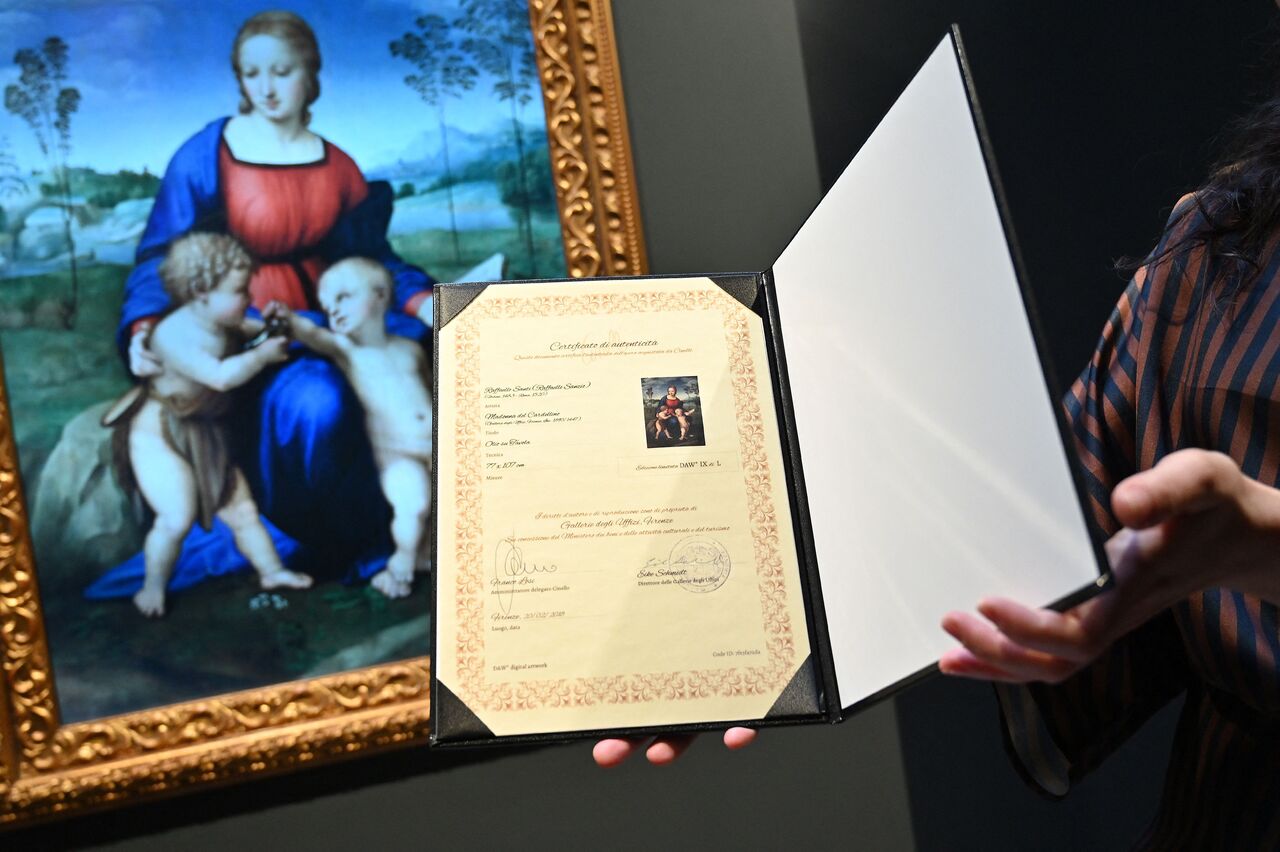Museums are cashing in on NFTs
Sign up now: Get ST's newsletters delivered to your inbox

A digital reproduction of the painting 'Madonna del Cardellino' by Raphael at the Unit London gallery in London on Feb 15, 2022.
PHOTO: AFP
Follow topic:
LONDON (NYTIMES) - "To wake up to one of these things is pretty special - to have a Leonardo at home," said Mr Joe Kennedy, director of contemporary art dealership Unit London, enthusing recently about an elaborately framed LED screen with a digital replica of Leonardo da Vinci's Portrait Of A Musician glowing on his gallery wall. The original was 1,300km away in the Ambrosiana museum in Milan.
The Leonardo was one of six ultra-high-resolution copies of famous paintings from across the centuries in Unit's Eternalising Art History exhibition, which closed last Saturday (March 26). The show was the latest attempt by cash-poor museums to generate money by selling non-fungible tokens, or NFTs. Last year, NFTs, usually pegged to the high-flying but volatile ethereum cryptocurrency, took the market for art and collectibles by storm, with sales estimated in the tens of billions.
Pandemic-related lockdowns and reprioritised government spending have put the world's public museums under financial pressure. Yet so far, despite the formidable sales figures being achieved by NFTs, few institutions have explored this digital asset as a fundraising mechanism.
Unit and its Florence-based technology partner Cinello forged licensing agreements with several prominent Italian museums to create a hybrid offering of limited-edition LED reproductions in period-style wooden frames, each accompanied by a unique NFT. Prices ranged from 100,000 to 500,000 euros per piece (S$150,000 to S$750,000). Fifty percent of sales proceeds went back to the licensing museums.
By last Friday, seven sales had been confirmed, generating up to 250,000 euros.
The collaboration between Unit and the Italian museums follows earlier attempts by other European institutions to get on the NFT bandwagon. Among those are the State Hermitage Museum in St Petersburg, Russia, which in September held an auction of NFT replicas of five of its best-known paintings that raised US$444,000 (S$598,000).
The Belvedere museum in Vienna has fractionalised the digitised image of Gustav Klimt's The Kiss into a one-off drop of 10,000 NFTs. This was released on Feb 14, Valentine's Day, priced at 0.65 ethereum, or 1,850 euros, each and generated about 4.3 million euros.
Producing NFTs uses a lot of energy. According to one estimate, the computing power required to mint one NFT generates the same amount of greenhouse gas as a 800km journey in a gasoline-powered car.
Environmental issues are one reason that barely a dozen museums have so far experimented with NFTs as an alternative revenue stream. The instability and opacity of unregulated cryptocurrencies, the difficulty of finding trusted tech partners and the cost of such partnerships are also cited by museum professionals as reasons for hesitancy.
One institution that has wasted no time embracing NFTs as a fundraising tool is the British Museum in London. Chaired by Mr George Osborne, a former British finance minister, the museum entered into an exclusive five-year partnership last September with ethereum-based NFT platform LaCollection. The museum has since made several token drops, in editions varying in size from two to 10,000, using digital copies of works by Katsushika Hokusai and J.M.W. Turner. Prices ranged from US$500 to US$40,000. Sales have reached seven figures last month, according to Ms Sophie Reid, spokeswoman for the project.
Aware of the environmental sensitivity of large-scale token drops, LaCollection said on its website that "for each minted NFT, we plant a tree" that "more than offsets" the activity's carbon footprint.
At the moment, the market is relatively small. Publicly funded galleries are wary of cryptocurrencies, and, for those immersed in that world, digitalised old art doesn't have the speculative cool of "native" NFTs, like CryptoPunks or Bored Apes, which can sell for millions. As yet, no museum NFTs have achieved attention-grabbing profits on resale platforms like OpenSea.
On the final day of the Eternalising Art History show, Ms Eve Smith, a lawyer, seemed impressed by the digital copy of Francesco Hayez's 1896 painting of embracing lovers, The Kiss, in the Pinacoteca Brera museum in Milan.
"It looks like satin. It looks like there's texture in what you're looking at, but there isn't," Ms Smith said. "Will I still want to go to the Brera? Of course."
But would she be prepared to pay Unit London's asking price of 180,000 euros to own one of the edition of nine, plus its NFT?
"It depends how much you like repro," Ms Smith said.

